Contents
- 1 Introduction to Mood Disorders
- 2 Types of Mood Disorders
- 3 The Science Behind Mood Disorders
- 4 Impact on Daily Life and Relationships
- 5 Treatment Approaches for Mood Disorders
- 6 Coping Strategies and Self-Care for Mood Disorders
- 7 Breaking the Stigma and Seeking Help
- 8 Living with Mood Disorders: Personal Stories and Insights
- 9 The Road to Recovery and Management
- 10 Conclusion
- 11 References
Introduction to Mood Disorders
Mood disorders stand as a significant component of mental health concerns, impacting millions of lives globally. Mood disorders encompass a group of mental health conditions characterized by persistent disturbances in emotional states that significantly affect an individual’s well-being, behavior, and overall quality of life. These disorders create a profound alteration in mood, leading to emotional extremes that change from the usual range of feelings experienced by a person.
Mood disorders can manifest in various forms, such as:
- Depression
- Bipolar disorder
- Cyclothymic disorder
- Depressive disorder (dysthymia)
Each condition presents unique patterns of mood swings, durations of mood states, and their associated symptoms.
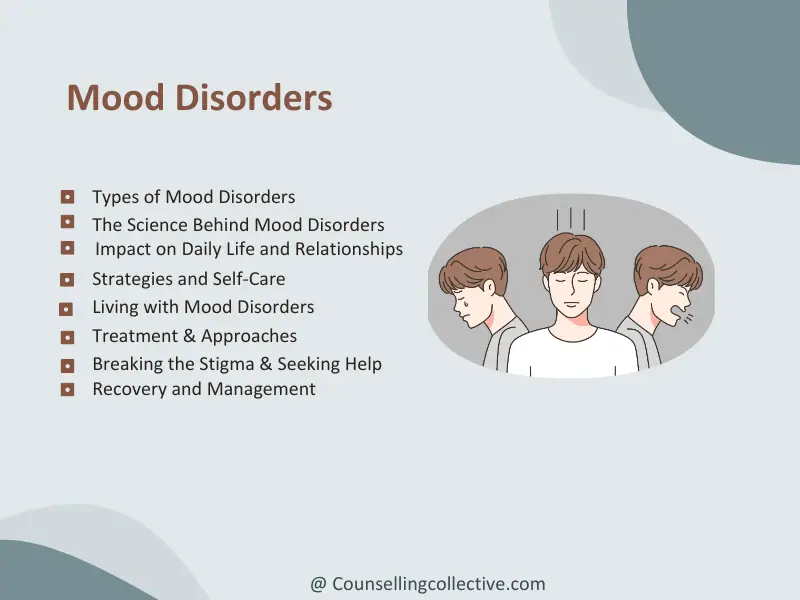
Depression, for instance, leads to overwhelming feelings of sadness, hopelessness, and the loss of interest in activities once enjoyed. In contrast, Bipolar disorder involves alternating periods of manic episodes, characterized by elevated energy and impulsivity, and depressive episodes mirroring the symptoms of major depression.
The Prevalence of Mood Disorders
The prevalence of mood disorders is startling, with a considerable impact on global health. According to the World Health Organization (WHO), depression, a prominent mood disorder, is a leading cause of disability worldwide.
Over 264 million people of all ages are estimated to suffer from depression, and the number is continuously rising. Furthermore, bipolar disorder, though less common, affects approximately 45 million individuals globally.
The implications of mood disorders extend beyond individual suffering. The economic burden they impose is significant, involving healthcare costs, lost productivity, and reduced quality of life.
Recognizing the prevalence of mood disorders underscores the urgency of addressing them with effective interventions and support systems.[1]
Types of Mood Disorders
Mood disorders encompass a spectrum of conditions that profoundly influence emotional well-being and overall mental health.
let’s explore the intricacies of various types of mood disorders, shedding light on their distinctive characteristics and underlying causes.
Major Depressive Disorder (MDD):
Major Depressive Disorder is a prevalent mood disorder characterized by pervasive feelings of sadness, hopelessness, and loss of interest or pleasure.
Symptoms:
It includes emotional distress, disrupted sleep patterns, appetite fluctuations, and cognitive challenges like difficulty concentrating.
Subtypes:
- Atypical Depression: Mood reactivity, increased appetite, weight gain, excessive sleep.
- Melancholic Depression: Severe symptoms, early morning awakenings, significant weight loss, pronounced guilt or agitation.
- Psychotic Depression: Involves depressive symptoms and delusions or hallucinations.
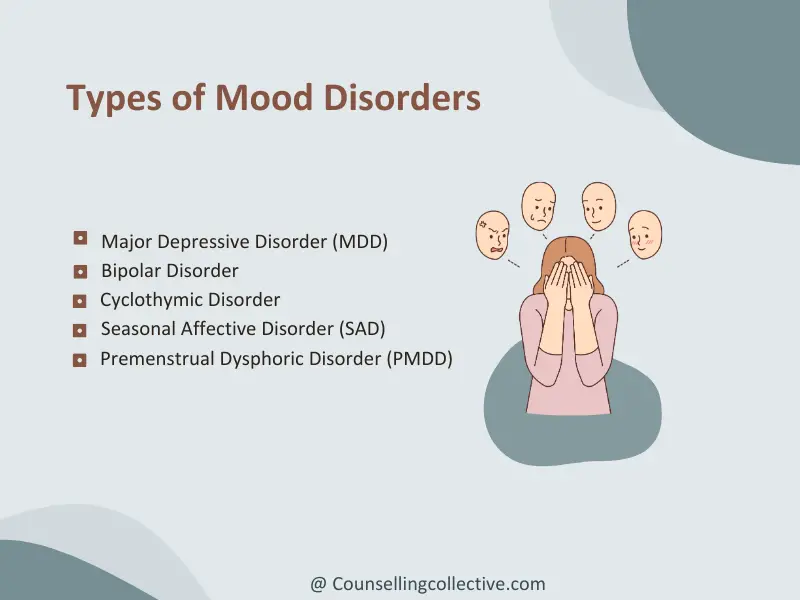
Bipolar Disorder:
Bipolar disorder is characterized by extreme mood swings, cycling between episodes of mania (elevated energy) and depression.
Symptoms:
Manic Episodes: Elevated energy levels, impulsive behavior, heightened self-esteem, reduced need for sleep.
Depressive Episodes: Mirror symptoms of Major Depressive Disorder.
Subtypes:
- Bipolar I Disorder: Manic episodes lasting at least a week, often requiring hospitalization.
- Bipolar II Disorder: Less intense manic episodes (hypomania) and depressive episodes.
- Cyclothymic Disorder: Periods of hypomania and mild depression lasting at least two years.
Cyclothymic Disorder: Fluctuating Mood Swings
Cyclothymic Disorder involves chronic mood fluctuations that are less severe than those observed in Bipolar Disorder. it is less severe than those observed in Bipolar Disorder.
Duration Criteria:
- Periods of hypomanic and mild depressive symptoms persist for at least two years.
- Doesn’t meet the criteria for a full-blown manic or depressive episode.
Impact on Functioning:
- Mood swings can impact stable relationships.
- Consistent engagement in daily activities is challenging.
Seasonal Affective Disorder (SAD):
This disorder follows a seasonal pattern, typically emerging in fall and winter with reduced sunlight.
Symptoms:
- Depression symptoms include low energy, lethargy, increased sleep, and weight gain.
Improvement with Sunlight:
- Symptoms tend to improve as seasons change, and more sunlight becomes available.
Premenstrual Dysphoric Disorder (PMDD):
Premenstrual Dysphoric Disorder (PMDD) is a severe form of premenstrual syndrome (PMS) that affects a small percentage of menstruating individuals.
Symptoms:
- Intense mood swings, irritability, and physical symptoms in a week or two leading up to menstruation.
Impact on Daily Functioning:
- Significant impact on daily functioning and relationships.
Accurate diagnosis and effective treatment of mood disorders rely on a nuanced grasp of their varied spectrum. Tailored interventions are essential to address the distinctive challenges posed by each subtype, emphasizing the need for nuanced approaches.
Recognizing the unique nuances of conditions like chronic low mood (dysthymia), cyclic swings (cyclothymia), seasonal shifts (SAD), and menstrual-linked changes (PMDD) is crucial.[2]
The Science Behind Mood Disorders
Mood disorders are complex and multifaceted conditions that arise from a combination of genetic, neurobiological, and environmental factors. Understanding the underlying scientific mechanisms behind these disorders is essential for providing effective treatment and support.
Let’s explore the science behind mood disorders, exploring how neurobiology, genetics, and environmental triggers contribute to their development. [3]
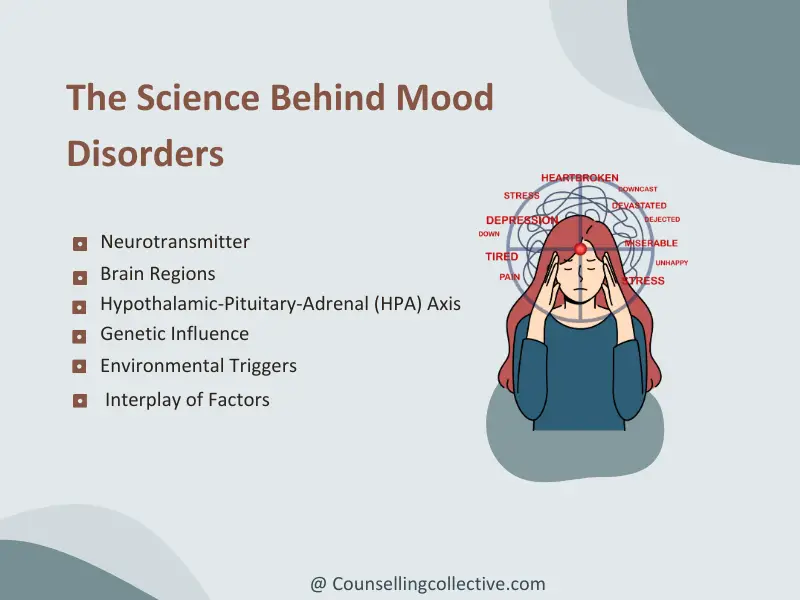
| Factors | Neurobiological | Genetic Predisposition | Environmental Triggers |
| Neurotransmitter | Role in mood regulation | Imbalance in serotonin, norepinephrine, dopamine | Dysregulation in the HPA axis contributes to heightened stress responses. |
| norepinephrine, dopamine) | |||
| Brain Regions | Emotional processing(amygdala, prefrontal cortex) | Abnormalities in size and functioning observed in individuals with mood disorders | Childhood adversity(neglect, abuse) |
| **Hypothalamic-Pituitary-Adrenal (HPA) Axis** | Stress response | Interplay with environmental factors determines the onset | |
| Genetic Influence | Family history | Heritability indicates genetic factors play a significant role | The complex interaction of neurobiological,genetic, and environmental |
| Environmental Triggers | Stress, trauma, life events | Impact on developing mood disorders | Childhood adversity can increase vulnerability to mood disorders |
| Interplay of Factors | The complex interaction of neurobiological, genetic, and environmental | Genetic predisposition interacts with environmental factors | Gene-environment interactions play a crucial role |
Impact on Daily Life and Relationships
Mood disorders cast a significant shadow over an individual’s daily life and can profoundly affect various aspects of their functioning, from emotions and cognition to relationships.
Understanding the intricate ways in which these disorders impact daily life and relationships is essential for both individuals experiencing mood disorders and those who support them.
Emotional Turmoil
(How Mood Disorders Affect Feelings and Emotions)
Individuals grappling with mood disorders often experience a rollercoaster of emotions that extend beyond normal mood fluctuations.
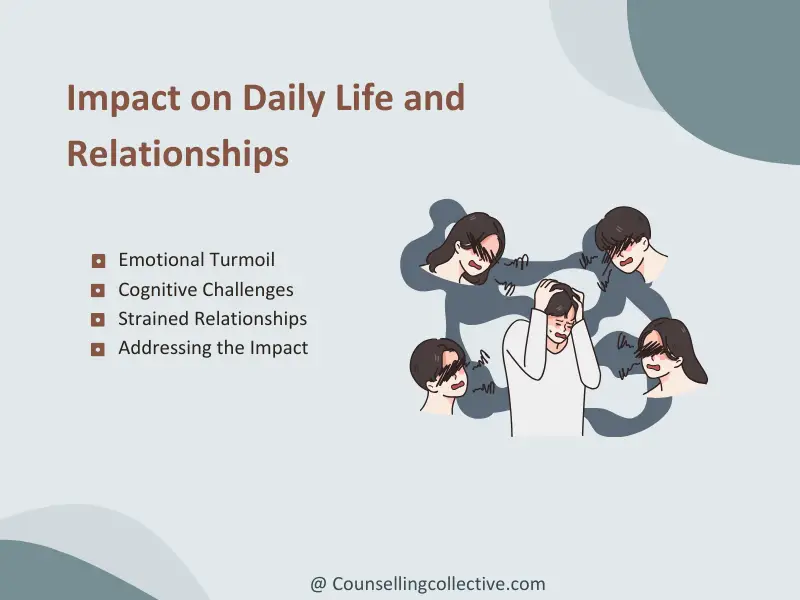
For example; depressive disorder, a prevailing sense of sadness, hopelessness, and emptiness can overwhelm one’s emotional landscape. On the other hand, bipolar disorder is characterized by extreme mood swings, oscillating between depressive episodes and periods of heightened energy and euphoria during manic episodes. These emotional shifts can disrupt an individual’s ability to engage with:
- Life’s activities
- Affecting work
- Hobbies
- Personal relationships
It’s not uncommon for individuals with mood disorders to withdraw from social interactions and isolate themselves due to the intensity of their emotions.
Cognitive Challenges
(Impaired Thinking and Decision-Making)
Mood disorders can also exert a significant toll on cognitive functioning.
Symptoms are such as:
- Difficulty concentrating
- Impaired memory
- Reduced attention span
The persistent cloud of negative thoughts and emotions can make even simple tasks feel overwhelming. This cognitive fog is particularly prominent during depressive episodes and can hinder an individual’s ability to perform effectively at work or school.
In bipolar disorder’s manic phase, racing thoughts and impulsivity may lead to poor decision-making and risky behaviors. This cognitive distortion during manic episodes can have lasting consequences, affecting finances, relationships, and overall life stability.
Strained Relationships
(Navigating Interpersonal Difficulties Due to Mood Disorders)
Mood disorders can strain even the closest of relationships. The emotional turmoil and cognitive challenges that individuals face can make it challenging to maintain healthy interactions with family, friends, and colleagues.
Loved ones may struggle to comprehend the sudden mood shifts or the withdrawal that often accompanies these disorders.
Interpersonal relationships can be further complicated by the stigma surrounding mental health. Individuals with mood disorders might fear judgment or misunderstanding from others, which can lead to isolation and secrecy.
Navigating these difficulties requires open communication, empathy, and a deeper understanding of the nuances of mood disorders.
Addressing the Impact
(Treatment and Support)
Recognizing the multifaceted impact of mood disorders on daily life and relationships underscores the importance of seeking appropriate treatment and support. A comprehensive treatment plan often involves a combination of psychotherapy, medication, lifestyle modifications, and social support.
- Psychotherapy:
- Cognitive-behavioral therapy (CBT) and dialectical behavior therapy (DBT) are effective.
- Helps individuals develop coping strategies, manage emotional distress, and improve cognitive functioning.
- Medications:
- Prescribed by a mental health professional.
- It may alleviate symptoms and stabilize mood swings.
- Lifestyle Changes:
- Regular exercise, balanced nutrition, and sufficient sleep complement formal treatment.
- Social Support:
- Engaging in social activities and cultivating a support network are crucial.
- Combats isolation and maintains a sense of belonging.
- Role of Friends and Family:
- Support from loved ones is pivotal in the recovery journey.
- Education about mood disorders, active listening, and providing empathy without judgment are essential.
- Creating a Supportive Environment:
- Establishing understanding and acceptance eases the challenges posed by mood disorders.
- Fosters an environment conducive to the well-being of individuals navigating mood disorders.[4]
Treatment Approaches for Mood Disorders
Addressing mood disorders necessitates a comprehensive and tailored treatment plan that considers the individual’s specific symptoms, needs, and preferences.
Treatment approaches for mood disorders encompass a range of strategies, from medications and psychotherapy to lifestyle interventions and complementary therapies. Let’s explore the various avenues individuals can pursue in their journey toward recovery and improved well-being.
[5]
Medications
- Antidepressants
- SSRIs, SNRIs, are a typical Individualized choice based on diagnosis and response.
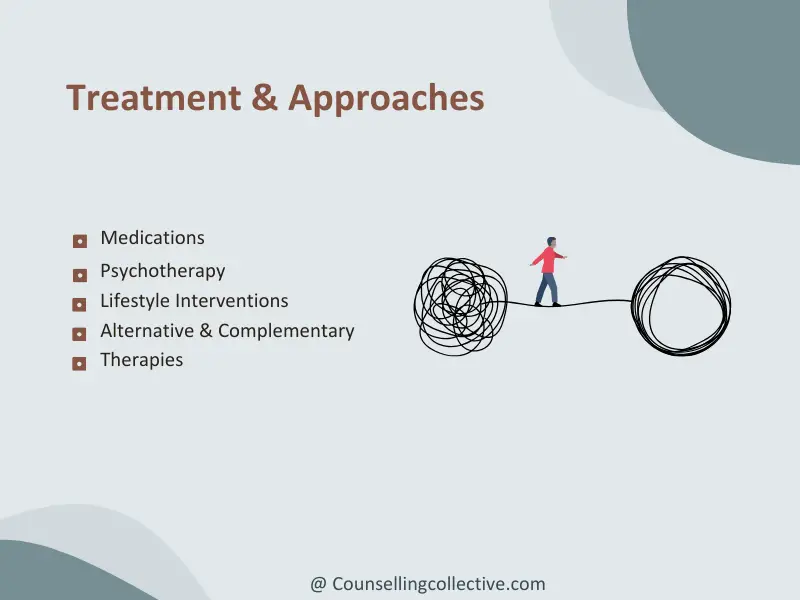
Psychotherapy
- Cognitive Behavioral Therapy (CBT) Dialectical Behavioral Therapy (DBT)
- Identifying/challenging negative thought patterns.Changing thought patterns for improved mood
- Psychodynamic Therapy and Interpersonal Therapy
Lifestyle Interventions
- Exercise: Antidepressant effects, stress reduction, improved sleep.
- Balanced Diet: Brain health support, omega-3 fatty acids.
- Avoid processed foods, sugary snacks and caffeine.- Sleep hygiene: Consistent schedule, comfortable environment.
Alternative & Complementary Therapies
- Mindfulness Meditation: Stress reduction, emotional regulation, well-being.
- Yoga: Mind-body focus, mood improvement.
- Art Therapy: Creative emotional expression.
- Music Therapy: Emotional expression and relaxation.
- Aromatherapy: Relaxation and mood support.
Coping Strategies and Self-Care for Mood Disorders
Coping with mood disorders involves a comprehensive approach that encompasses both professional treatment and personal strategies for managing symptoms and promoting overall well-being.
This section explores various coping strategies and self-care techniques that individuals can adopt to navigate the challenges posed by mood disorders and enhance their quality of life.
- Building a Support System Friends and family provide emotional support. Talking about experiences fosters a sense of belonging. Support groups offer validation, empathy, and a sense of community.
- Stress Management: Techniques include deep breathing and guided imagery. Regular physical activity reduces stress. Time management prevents overwhelm.
- Mindfulness and Mind-Body Practices: Mindfulness reduces symptoms of depression and anxiety. Yoga promotes physical well-being and emotional connection. Encourages self-awareness and inner peace.
- Setting Realistic Goals: Break large tasks into manageable steps. Small achievements boost self-esteem and motivation. Celebrating progress reinforces personal resilience.
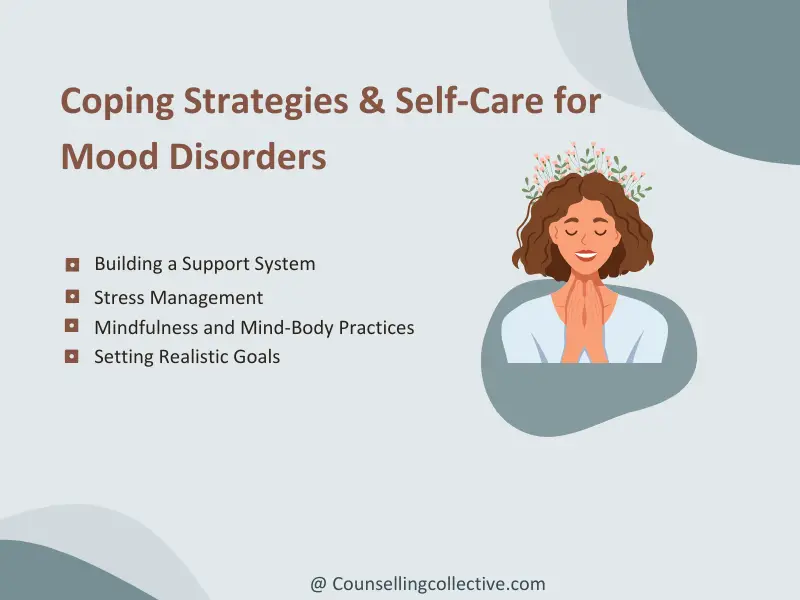
Celebrating these small victories is essential. Recognizing progress, no matter how incremental reinforces a sense of accomplishment and reinforces the idea that positive change is possible. [6]
Breaking the Stigma and Seeking Help
Mood disorders continue to be a significant public health concern, affecting millions of individuals across the globe. However, a pervasive stigma surrounding mental health issues often prevents those in need from seeking the help they require.
This section addresses the importance of challenging the stigma around mood disorders, recognizing the signs that it’s time to seek professional help, and what to expect during the therapeutic process.
The Importance of Mental Health Awareness
- Destigmatization: Challenge societal misconceptions and discrimination to create a supportive mental health environment.
- Open Discussions: Promote mental health awareness through educational campaigns, media initiatives, and community dialogues.
- Role Models: Encourage public figures to openly share their mental health challenges, normalizing discussions and reducing fear of judgment.
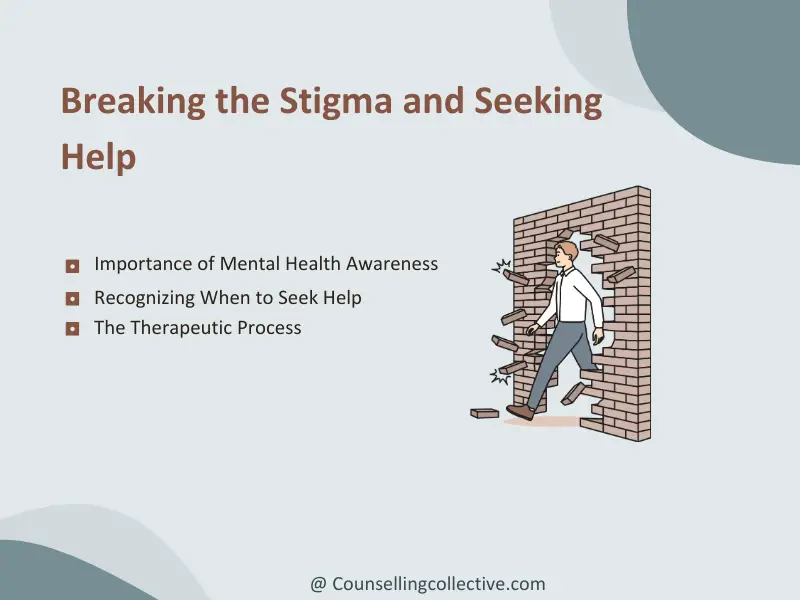
Recognizing When to Seek Help
- Persistent Symptoms: Pay attention to ongoing feelings of sadness, hopelessness, anxiety, and noticeable changes in sleep, appetite, and energy levels.
- Duration of Symptoms: Seek professional help if symptoms persist for more than two weeks and significantly disrupt daily life.
- Urgent Attention: Immediately reach out for professional assistance when experiencing thoughts of self-harm or suicide.
The Therapeutic Process
- Psychotherapy (Talk Therapy):
- Cognitive Behavioral Therapy (CBT): Identify and address negative thought patterns, develop healthy coping strategies.
- Dialectical Behavioral Therapy (DBT): Enhance emotional regulation skills.
- Medication:
- Antidepressants and Mood Stabilizers: Prescribed by a psychiatrist to restore chemical imbalances, closely monitored for effectiveness.
- Collaborative Care:
- Team Approach: Involves therapists, psychiatrists, and healthcare professionals.
- Comprehensive Treatment: Ensures all aspects of an individual’s condition are addressed for better outcomes.
- Holistic Approaches:
- Integrative Treatments: Combine traditional therapy with holistic methods like yoga, mindfulness, and art therapy.
- Mind-Body Focus: Provides a diverse toolkit for managing mental health conditions. [7]
Living with Mood Disorders: Personal Stories and Insights
Real-life experiences provide invaluable insights into the challenges and triumphs of individuals living with mood disorders.
This section helps you to find personal accounts of those who navigate the complexities of mood disorders, as well as the strategies they engage to manage and thrive despite their conditions.
Real-Life Experiences: Personal Accounts of Individuals Living with Mood Disorders
- Unique Journeys: Each individual’s journey with a mood disorder is distinct, offering a glimpse into the daily realities, emotions, and coping mechanisms they employ. These narratives underscore the diversity of experiences, emphasizing that individuals facing mood disorders are not alone in their struggles.
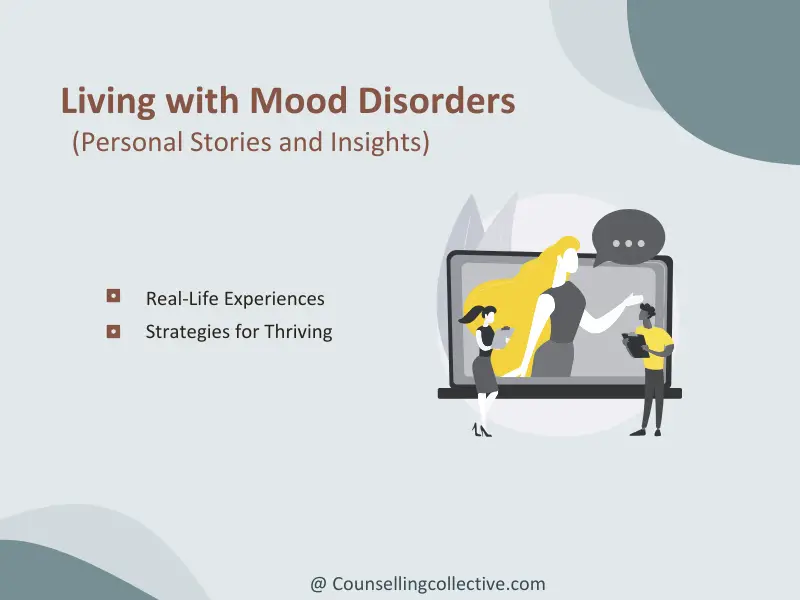
- Overcoming Challenges: Some share stories of triumph, highlighting resilience in the face of adversity. Others illuminate the dynamic nature of mood disorders, detailing the ebb and flow of symptoms. By sharing their journeys, individuals contribute to breaking the isolation and dismantling the stigma surrounding mood disorders.
Strategies for Thriving: How Individuals Manage and Thrive Despite Mood Disorders
- Self-Care and Routine:
- Establishing and adhering to self-care routines is pivotal for managing mood disorders.
- Regular exercise, balanced nutrition, and sufficient sleep contribute to overall well-being, providing stability and aiding in mood regulation.
- Medication and Therapy:
- Many find relief through a combination of prescribed medications and therapy sessions.
- Medications stabilize mood, while therapy equips individuals with coping skills and tools to effectively manage symptoms.
- Support Systems:
- Building a robust support network is essential.
- Friends, family, support groups, and therapists offer emotional validation and encouragement, creating safe spaces for sharing feelings, experiences, and challenges.
- Mindfulness and Stress Reduction:
- Incorporating mindfulness practices, like meditation and deep breathing exercises, helps manage stress and keeps individuals present.
- Cultivating mindfulness empowers individuals to gain control over responses to emotional triggers.
- Pursuing Passions:
- Engaging in activities that bring joy and fulfillment positively impacts mood.
- Pursuing hobbies, interests, and creative outlets provides a sense of purpose and accomplishment.
- Positive Affirmations:
- Integrating positive affirmations into daily routines reframes negative thought patterns.
- Repeating affirmations promoting self-acceptance and resilience gradually reshapes self-perception.
- Seeking Professional Help:
- Regular therapy sessions and check-ins with healthcare providers offer ongoing guidance and adjustments to treatment plans.
- Professional guidance is invaluable for maintaining overall well-being and navigating the complexities of mood disorders.[8]
The Road to Recovery and Management
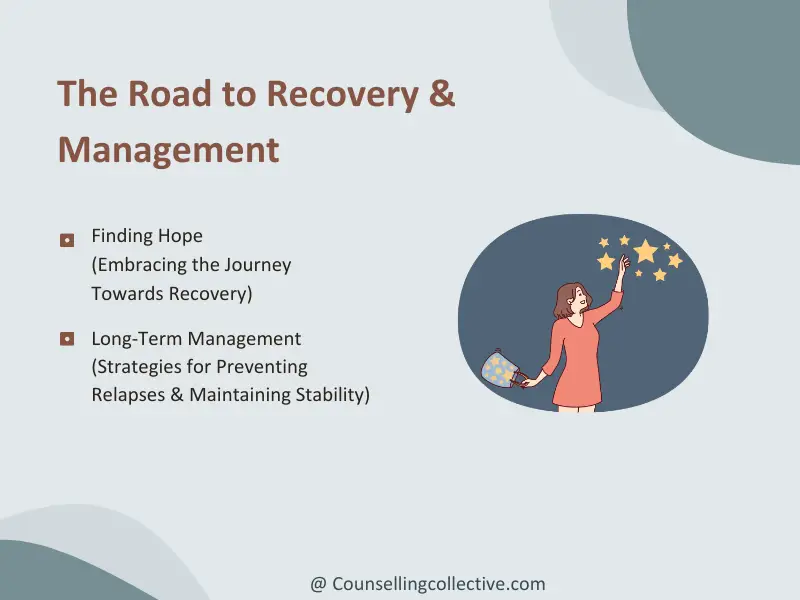
Recovery from mood disorders is a journey marked by its unique challenges and triumphs.
This table explores the path individuals undertake in finding hope and embracing recovery, as well as the strategies necessary for preventing relapses and maintaining long-term stability.[9]
| Section | Key Points |
| Finding Hope: (Embracing the Journey Towards Recovery) | Recovery involves healing and growth, not just symptom alleviation. Acknowledging the disorder, seeking professional help, and proactive well-being are vital. Seeking help is a sign of strength; therapy and medication (e.g. CBT, DBT) play crucial roles. Education empowers informed decisions and self-advocacy. Support networks (family, friends, groups) reduce isolation and offer empathetic understanding. |
| Long-Term Management: (Strategies for Preventing Relapses and Maintaining Stability) | Recovery is ongoing; mood disorders may involve remission and relapse. Consistency in therapy, medication, and check-ins is crucial. Lifestyle choices impact stability (exercise, diet, sleep, avoiding substance abuse). Stress management (mindfulness, deep breathing) is key. Recognizing early signs of relapse and creating a prevention plan is crucial. Building resilience involves problem-solving, adaptive thinking, and positivity. Holistic approaches (yoga, meditation, art therapy) contribute to overall well-being. |
Conclusion
In conclusion, addressing the profound impact of mood disorders on individuals necessitates a collective commitment to understanding and compassion.
Education emerges as a potent force in dispelling stigma by providing accurate information and insights into the challenges faced by those living with mood disorders.
By fostering a variation comprehension of these conditions and emphasizing their status as legitimate medical issues, society can create an inclusive environment that mitigates the fear of judgment or discrimination hindering help-seeking behaviors.
Compassion, grounded in active listening, understanding, and support, becomes pivotal in this endeavor.
Recognizing the importance of language, resource awareness, and the non-linear nature of recovery, society can play a transformative role in destigmatizing mood disorders, ensuring that individuals feel validated, accepted, and empowered to seek the necessary help without shame.
References
- Ghaemi, S. N. (2008). Mood Disorders: A Practical Guide. Amazon
- Jamison, K. R. (1995). Manic-Depressive Illness: Bipolar Disorders and Recurrent Depression (2nd ed.). Amazon.
- Nestler, E., Hyman, S., & Malenka, R. (2009). Molecular Neuropharmacology: A Foundation for Clinical Neuroscience (4th ed.). Amazon.
- Iversen, L., Iversen, S., & Bloom, F. E. (Year). Introduction to Neuropsychopharmacology (1st ed.). Amazon.
- Otto, M., Reilly-Harrington, N., & Knauz, R. O. (Year). Living with Bipolar Disorder: A Guide for Individuals and Families (1st ed.).Amazon.
- Sachs, G. S., & Thase, M. E. (2007). Treatment of Bipolar Disorder: A Guide for Patients and Families.
- Miklowitz, D. J. (2008). The Bipolar Teen: What You Can Do to Help Your Child and Your Family. Amazon.
- Pescosolido, B. A., Martin, J. K., Lang, A., & Olafsdottir, S. (2008). Rethinking the Stigma of Mental Illness. Oxford University Press.
- Greenberg, G. (2007). Manufacturing Depression: The Secret History of a Modern Disease. Amazon.
- Pavuluri, M. N., & Graczyk, P. A. (2018). Child and Adolescent Bipolar Disorder: A Comprehensive Textbook.
